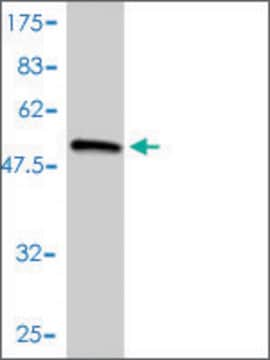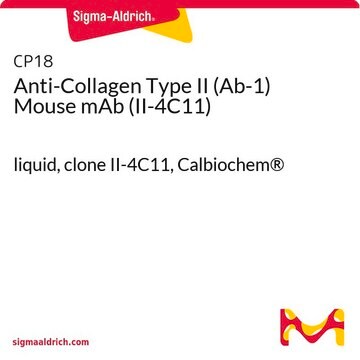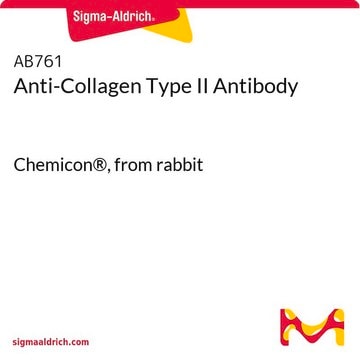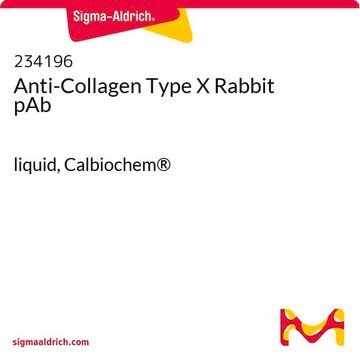MAB1330
Anti-Collagen Type II Antibody, clone COLL-II
ascites fluid, clone COLL-II, Chemicon®
Synonim(y):
Anti-ANFH, Anti-AOM, Anti-COL11A3, Anti-SEDC, Anti-STL1
Wybierz wielkość
Wybierz wielkość
About This Item
IHC
immunohistochemistry: suitable
Polecane produkty
pochodzenie biologiczne
mouse
Poziom jakości
forma przeciwciała
ascites fluid
rodzaj przeciwciała
primary antibodies
klon
COLL-II, monoclonal
reaktywność gatunkowa
sheep, human, bovine, rat, pig, mouse, canine
producent / nazwa handlowa
Chemicon®
metody
ELISA: suitable
immunohistochemistry: suitable
izotyp
IgG1
numer dostępu NCBI
numer dostępu UniProt
Warunki transportu
dry ice
docelowa modyfikacja potranslacyjna
unmodified
informacje o genach
human ... COL2A1(1280)
Specyficzność
Immunogen
Zastosowanie
Western Blot: 1:1000-1:2000 with chemiluminescent detection
ELISA at 1:100-1:500, pepsin treated samples.
Optimal working dilutions must be determined by the end user.
Cell Structure
ECM Proteins
Postać fizyczna
Przechowywanie i stabilność
Komentarz do analizy
Cartilage in lung or fetus
Inne uwagi
Informacje prawne
Oświadczenie o zrzeczeniu się odpowiedzialności
Nie możesz znaleźć właściwego produktu?
Wypróbuj nasz Narzędzie selektora produktów.
Kod klasy składowania
11 - Combustible Solids
Klasa zagrożenia wodnego (WGK)
WGK 1
Temperatura zapłonu (°F)
Not applicable
Temperatura zapłonu (°C)
Not applicable
Certyfikaty analizy (CoA)
Poszukaj Certyfikaty analizy (CoA), wpisując numer partii/serii produktów. Numery serii i partii można znaleźć na etykiecie produktu po słowach „seria” lub „partia”.
Masz już ten produkt?
Dokumenty związane z niedawno zakupionymi produktami zostały zamieszczone w Bibliotece dokumentów.
Active Filters
Nasz zespół naukowców ma doświadczenie we wszystkich obszarach badań, w tym w naukach przyrodniczych, materiałoznawstwie, syntezie chemicznej, chromatografii, analityce i wielu innych dziedzinach.
Skontaktuj się z zespołem ds. pomocy technicznej








